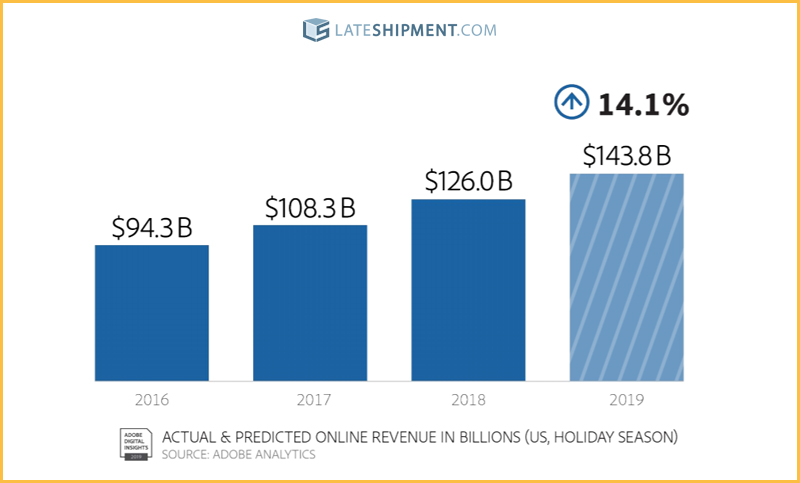A Record-Breaking Shopping Season
Online spending is at an all-time high this holiday season. Data from Adobe Analytics suggests that web spending may have witnessed an increase of 14.1% over the 2018 season. In contrast, purchases at brick-and-mortar locations have witnessed a modest 4.0% growth.
The shift from physical to web-based shopping is afoot.

A pre-season study by the National Retail Federation had predicted an increase in consumer spending by 3.8 to 4.2 percent during the period. It based the prediction on factors like the robustness of the economy, low unemployment rates, all-time high consumer confidence, and the retail sales forecast of the commerce department.
The scale of online purchases this holiday season is staggering. Consumers spent well over the forecast of $123.9 billion in the months of November and December compared to $108.8 billion last year.
This has, doubtless, been the biggest ever shopping season in the country.
While spending has increased across the generation spectrum, millennials (also called Gen Y’ers) have contributed the most to the season’s numbers.

Millennials’ Online Shopping Preferences
A nationwide study of shopping trends served up the following findings:
- Most millennials surveyed indicated that they would be spending more this season.
- 69% of millennials said they would use their phones to shop online, a higher percentage than desktops or laptops.
- 30% of the millennials said ads influenced their purchasing decision more than word-of-mouth.
- 95% of the millennials surveyed were more loyal to stores where they were rewards members.
- Around 45% of millennials say same-day delivery is important, which shows the generation’s demand for convenience online.
Discover’s annual holiday shopping survey provided some insight into why millennials are prolific spenders. 45% of those surveyed suggested that higher wages spurred their spending habits.
According to a survey by Accenture, Gen Y cares deeply about inclusion and workplace diversity.
Most millennials are inclined to choose brands that demonstrate diversity in promotions.
The Most Popular Products This Season
While analytics organizations don’t categorize online shopping data by generation, we are able to make a reasonable guess of what millennials have been buying online during the season by taking a look at the most popular products on key days.
According to Amazon, the most popular products were toys. Particularly L.O.L Surprise, Frozen 2 toys, and a variety of toys from LEGO, including Star Wars Darth Vader Castle and NASA’s Apollo Saturn V sets.
Some other popular products were gaming devices like Nintendo Switch and SEGA Genesis Mini, and electronic devices such as VR devices and Samsung TVs.
A Closer Look at Millennials
The generation of those born between 1981 and 1997 is widely considered to be both tech-savvy and materialistic and makes its shopping decisions based on its beliefs and values.
Millennials are passionate about the world they inhabit and often assess factors like the environmental footprint of a product and the social responsibility of a brand before making a purchase decision.
At the same time, they are also instinctual. They are heavily influenced by social media trends and the choices their peers make.
They are anxious to be seen making the spending choices that win them the approval of their peers.
In general, millennials are distrustful of financial professionals and often consider them to work out of a vested interest of self-enrichment.
One of the notable traits of Gen Y’ers is their short attention span.
Capturing their attention involves being innovative rather than jostling with the thousands of marketing messages they encounter on a daily basis.
The average millennial is subscribed to numerous emailing lists and is constantly bombarded by offers and inducements to purchase.
While millennials are generally open to sampling new products and deals, they dislike mass-marketing campaigns that are not tailored to their needs and interests.
They keep themselves updated on the latest products, prices, and reviews and value brands that are open and fair with their offers.
One feature that millennials share with other generations is that women are generally more frugal with their expenses and more likely to save than men.
Successfully marketing to Gen Y’ers is a big step toward boosting product sales and ensuring profitability.
Gaining and maintaining attention in the advertising cacophony they experience daily involves a strategic approach.
Appealing to the average millennial’s concern for the environment and sense of advocacy is a method successfully employed by brands that show their processes and products to be eco-friendly and sustainable.
Running innovative and out-of-the-ordinary campaigns on social media channels is another method that works with this demographic.
When running campaigns on websites and social media, using behavior data ensures that individual targeting is spot-on and relevant.
As the average millennial receives a large number of emails daily, the key to impressing them lies in delivering relevant and timely messaging that offers a learning experience.
Since millennials are naturally inquisitive about the latest and greatest products in various categories on the market, keeping them updated with product releases and providing them with tailored deals earns their attention.
The most important thing to remember when marketing to Gen Y’ers is to look at things from their perspective and use an empathetic tone in messaging.
Conclusion
Fulfilling the expectations of millennials is critical to the success of any online business that ships to the U.S. One of them is making sure that packages arrive on time.
If you own a business that ships products, consider signing up for a LateShipment.com account.
LateShipment.com is the world’s only logistics cloud tool that helps businesses of every size reduce shipping costs by up to 20% and provide memorable delivery experiences to customers at scale.
Some of our high-impact offerings are :
- Save up to 20% on Shipping – Automatically audit your shipping carriers’ invoices and recover refunds for 50+ service failures & billing errors including late deliveries.
- Real-Time Visibility – Monitor your outbound & inbound shipments across multiple shipping carriers on a centralized window, in real-time.
- Critical Delivery Alerts – Pay attention to daily deliveries with predictive delay alerts and more on a purpose-built dashboard for support reps.
- Proactive Issue Resolution – Proactively communicate with customers to prevent them from having bad experiences due to delivery failures.
- Custom Delivery Notifications – Send custom or automated delivery status notifications for events like “shipped,” “attempted,” & “delivered.”
- Branded Tracking Pages – Build fully-customizable order tracking pages for your customers to improve brand recall and sales.
You can start using these features in less than 2 minutes without the need for any IT/business process change or coding. And the best thing is that LateShipment.com is a simple cloud-based plug-and-play solution that can seamlessly integrate with the tools you already use.
It’s that simple!







![Holiday Season Marketing Calendar and Shipping Deadlines [2021] Blog Header](https://lswordpress.s3.amazonaws.com/blog/wp-content/uploads/2021/08/17065221/Holiday-Season-Marketing-Calendar-and-Shipping-Deadlines-2021-Blog-Header-420x280.png)